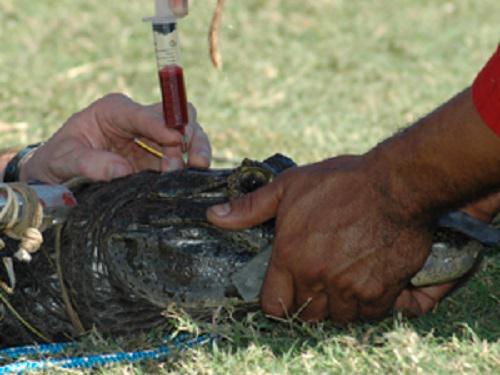Hamish Campbell
Other projects
14 Oct 2008
Using Caiman Yacare as a Sentinel Species to Monitor Environmental Degradation of the Pantanal, Wetlands Brazil II
The Paraguayan Caiman (C. yacare) is an ideal indicator species to monitor how anthropogenic disturbance and toxicants from mining and intensive farming are disrupting the fragile wetland ecosystem of the Pantanal.

Blood sampling.
The Pantanal wetlands have recently become under increasing environmental pressure due to changes in farming practice and land use. This project aims to form a collaborative body of local community, land owners and scientists to assess and monitor the ongoing environmental degradation.

Caiman with radio tag.
Over 3639 000 ha of land had been deforested for intensive agriculture of soya in the state which encompasses the Southern Pantanal. Each year Brazil applies over 50 000 tonnes of pesticide on soya plantations, and this is increasing by 21.7 % annually. The new wave of ‘round up’ soya pesticides are particularly harmful for insects, fish and birds, causing tumours, reproductive abnormalities and long-term genetic damage. The Pantanal acts as a drainage basin for the ‘soya plateau’ and the seasonal flood, which creates the Pantanal ecosystem, now has the potential to transport biologically hazardous anthropogenic inputs into pristine areas. Additionally, illegal gold mines are occurring in alarming abundance around Pantanal headwaters. The smelting process produces waste mercury and this toxic heavy metal has been found at high concentrations in some species of fish and piscivorous birds.
The Paraguayan Caiman (C. yacare) is found in abundance throughout the Pantanal in both pristine and heavily disturbed areas. It is an ideal sentinel species due to its low mobility, long life span, and its wide distribution in river systems and seasonally flooded wet lands. Additionally, its aquatic lifestyle and high position in the Pantanal food web make them potential biomagnifiers and bioaccumulators of organic and inorganic toxins. Using simple field techniques caiman health, growth, dispersal patterns, reproductive success and toxicological load will be assessed at chosen locations throughout the Pantanal. By comparing the caiman populations from polluted and clean sites we will be in a position to identify toxins that are transported through river systems and bioaccumulated or biomagnified through the Pantanal food web. Moreover, we can assess the resultant impact on health and reproductive success of an egg laying animal. This will be important in identifying potential threats to the approximately 500 species of bird present in the Pantanal. The 15-25 million caiman that exist in the Pantanal provide a practical solution to assessing potential toxicant load and deleterious effects to the many more endangered and fragile species (i.e. Jaguar, Manned wolf, Macaws).